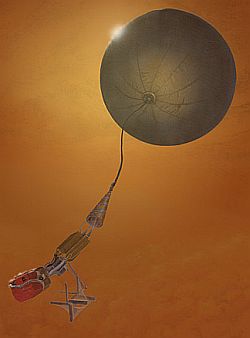 VEGA (Program)
VEGA (Program)

Vega 1 and Vega 2 were two unmanned spacecraft launched to Venus in December 1984, in a cooperative effort that involved the Soviet Union (who provided the spacecraft and launch vehicle), Austria, Bulgaria, Hungary, the German Democratic Republic, Poland, Czechoslovakia, France, and the Federal Republic of Germany. The mission had a double objective: to investigate Venus and also flyby Halley's Comet.
Vega 1 and 2 were identical sister ships and were a development of the earlier Venera craft. Vega 1 arrived at Venus on June 11, 1985 and Vega 2 on June 15, 1985. Each craft delivered a 1,500 kg, 240 cm diameter spherical descent unit. The units were released some days before each arrived at Venus and entered the atmosphere without active inclination changes. Each contained a lander and a balloon explorer.
The two balloon aerobots were designed to float at 54 km from the surface, in the most active layer of the Venusian cloud system.
The balloons were spherical superpressure types with a diameter of 3.54 metres and filled with helium. A gondola assembly weighing 6.9 kilograms and 1.3 meters long was connected to the balloon envelope by a tether 13 metres long. Total mass of the entire assembly was 21 kilograms.
The top section of the gondola assembly was capped by a conical antenna. Beneath the antenna was a module containing the radio transmitter and system control electronics. The lower section of the gondola assembly carried the instrument payload and batteries capable of operating for 60 hours.
The scientific instruments of each craft consisted of:
* An arm carrying thin-film resistance thermometers and a velocity anemometer. The anemometer consisted of a free-spinning plastic propeller whose spin was measured by LED-photodetector optointerrupters.
* A module containing a PIN diode photodetector to measure light levels and a vibrating quartz beam pressure sensor.
* A package at the bottom carrying the batteries and a nephelometer to measure cloud density through light reflection.
The signals transmited by the crafts were tracked by two networks of 20 radio telescopes divided in the Soviet network, coordinated by the USSR Academy of Sciences and the international network, coordinated by the Centre National de Etudes Spatiales (CNES).
The balloons were dropped onto the darkside of Venus and deployed at an altitude of about 50 kilometres, floating upward a few kilometres after reaching their equilibrium altitude. At this level, pressure and temperature conditions of Venus were similar to those of Earth, though the planet's winds moved at hurricane velocity and the carbon dioxide atmosphere was laced with sulfuric acid, along with smaller concentrations of hydrochloric and hydrofluoric acid.
The balloons moved swiftly across the night side of the planet into the light side, where their batteries finally ran down and contact was lost. Both Vega-1 and Vega-2 balloons operated for more than 46 hrs from injection to the final transmission.
Tracking indicated that the motion of the balloons included a surprising vertical component, revealing vertical motions of air masses that had not been detected by earlier probe missions.
Althought there are many other probes and designs currently under development, to the present day, these two missions are the only ones performed by balloons in the atmosphere of another planet.

